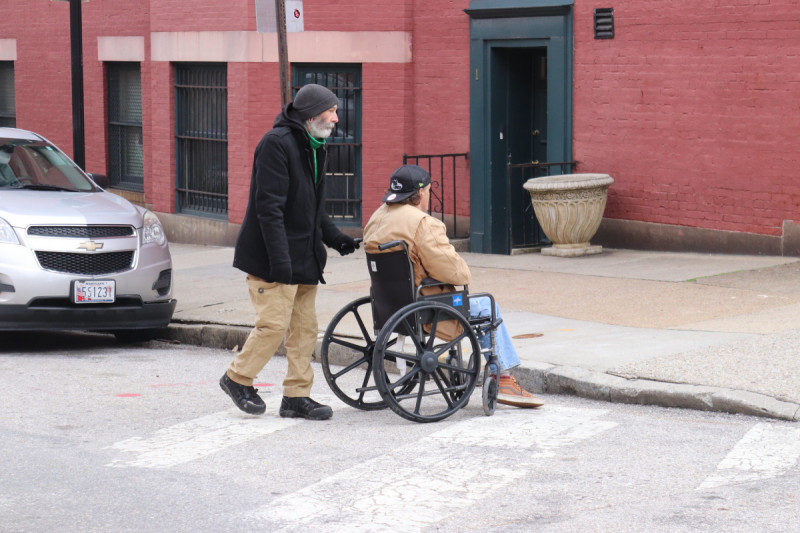A man pushes another man in a wheelchair along East Madison Street in Baltimore, Maryland. Image by Elvert Barnes licensed under Creative Commons.
This article was first published in Next City.
Last week, Laurel Mendez and her husband were bringing groceries to a donation site in Baltimore as they did several times a month. They got off the bus and immediately came across a seven-inch crack in the sidewalk.
“Between the broken sidewalks and the large gaps in the unrepaired sidewalks, I could hardly get from the bus stop to where I could actually roll my wheelchair,” says Mendez. “I had to cross the street and then cross my arms over my chest while barely steering my wheelchair with the other hand to get through a gap between uncut bushes and a protruding fence.”
Mendez is hardly alone, and her struggles are nothing new. In Baltimore, the city had a backlog of 6,700 sidewalk work requests as of August 2020.
This is compounded by the fact that the city has not retrofitted old sidewalks as needed, nor has it consistently built new sidewalks that meet ADA requirements like curb cuts and width and slope standards, claims a new class action lawsuit against the city of Baltimore.
The lawsuit, filed on June 10, is the latest attempt by accessibility advocates to redesign Baltimore’s sidewalks to meet the needs of the city’s mobility-impaired residents. “Data suggests that around 50,000 people in Baltimore live with a disability. There are tons more people visiting the city because it is so conference-heavy, “said Martie Lafferty, director of the Accessibility Project at the Civil Rights Education and Enforcement Center and an attorney on the case. “This problem is pretty obvious when you visit the city.” The complaint states that only 1.3% of the city’s 37,806 curb ramps examined in 2019 met ADA’s accessibility requirements.
Both Lafferty and Mike Bullis, the executive director of the IMAGE Center of Maryland – an organization that helps people with disabilities live independently – say they reached out to the city to try to work with them, but that the city not ready to come to the table. “We contacted the city in October 2020. We have set out the problem and explained the applicable law [sidewalk] Problems and offered to work with the city to resolve them. We had a talk with the city and one or two with their lawyer, ”says Lafferty. “Your reaction was lackluster at best. They said they recognized the problem, but still had a lot to do. “
So they sued. “It’s a huge problem and we felt like at that point we had to file an application to get the city to take it seriously,” she says. Bullis agrees. “We tried to get the city involved about a year ago, but they either delayed our letters or didn’t reply at all,” he says. “It became clear that they wouldn’t just play ball with us unless we sued.”
A press release from Mayor Brandon M. Scott in response to the lawsuit claims that “the city would not wait to be sued to begin implementing changes to meet ADA standards,” and says that a task force has been put together. Scott mainly blamed history for the problems. “My administration has inherited a number of longstanding challenges that we address with a true equity approach,” the press release reads.
“It was kind of a thought process about how we can make fundamental changes and how we can hold the city accountable,” says Bullis of the decision to file a lawsuit. “We have never done anything like this before, this is new to us. The best way to hold the city accountable is through the courts and a surveillance process. “
Lafferty says plaintiffs are not seeking compensation beyond attorney fees and costs associated with continuing the litigation. What they really want is change. Bullis hopes that changes can come without having to go through the often lengthy legal process. “We hope the city will work with us to develop a process that will allow us to put together a plan to make the city more welcoming and exciting for people with disabilities,” he says.
Based on Lafferty’s previous work, chances are the lawsuit can lead to the changes Bullis and the company are hoping for.
Lafferty’s organization and its co-chair “have successfully negotiated and then signed informed consent forms with several cities including Colorado Springs, Denver, Portland, San Jose, Seattle, Long Beach and Los Angeles,” she says. “As a result, the accessibility of the pedestrian paths in these cities is steadily improving. For example, there [the] By registering a consent decree in 2018, Portland improved access to the public right of way by installing and refurbishing 3,848 curb ramps. Our consent decree requires Portland to complete the installation / refurbishment of a total of 18,000 curb ramps by 2030 and they are on the right track. Similar results are seen in other cities we have worked with to remove inaccessible right of way for pedestrians, dramatically increasing the ability for people with mobility impairments to move around their cities independently. “

Cinnamon Janzer is a freelance journalist based in Minneapolis. Her work has appeared in National Geographic, US News & World Report, Rewire.news, and others. She has an MA in Social Design with a specialization in Interventional Design from the Maryland Institute College of Art and a BA in Cultural Anthropology and Fine Arts from the University of Minnesota, Twin Cities.


Comments are closed.